Читать книгу Urban Remote Sensing - Группа авторов - Страница 37
2.4.2.2 Synthetic Aperture Radar (SAR)
ОглавлениеWhile DSM results are applicable to numerous urban issues at the scale of 1 km, other studies require higher spatial resolution in the range of 10–100 m to identify and delineate local features such as detection of buildings along roadsides, in small villages, and on small islands. In this regard, X‐band SAR data such as the current CSK, TerraSAR‐X (TSX) and TDX, and the future LOTUSat‐1 (LS1) and LOTUSat‐2 (LS2) platforms will serve to increase spatial and temporal resolutions of the data with more frequent observations when multiple SAR datasets are used synergistically.
Here, we describe our theoretical approach for remote sensing of 3D urban building volume using satellite SAR data. The advancement here is that this new method can overcome and thus circumvent the limitation of Interferometric Synthetic Aperture Radar (InSAR) to determine building height as InSAR suffers from the overlay problem because buildings are typically constructed vertically (90° slope).
Consider a targeted area A in a high‐resolution SAR measurement with the geometry of the incidence field transmitted toward A and scatter field received from A with receivers at location a and as illustrated in Figure 2.12. For fully polarimetric interferometry measurement of A, the SAR covariance matrix C χ is defined with the second‐rank tensor (see Eq. (2.4)):
(2.4)
where each element χ is a bistatic polarimetric scattering coefficient, with the horizontal (h) or vertical (v) polarization of the incidence and scattered fields E, is given by the relation:
FIGURE 2.12 Geometry of incidence and scattered fields.
(2.5)
In Eq. (2.5), r is the distance between A and the receiver at location a or b; subscript i is for incidence field and s for scattered field; polarization μ , ν , τ , κ = h, v; and the asterisk indicates the complex conjugate. In the limit of a → b when the receivers are collocated, the bistatic scattering coefficient χ μντκ becomes polarimetric backscatter σ μντκ (Nghiem and van Zyl 1997). Per the definition by Eqs. (2.1) and (2.2), the vertical co‐polarized backscatter is σ vvvv = VV, the horizontal co‐polarized backscatter is σ hhhh = HH, and the cross‐polarized backscatter σ vhvh = VH, σ hvhv = HV, and σ vvvh is the polarimetric complex backscatter vvvh = vv × vh*. These terms can be obtained from Level‐1 single‐look complex data products from CSK, TSX, TDX, Sentinel SAR (STN), etc.
In the urban environment, radar backscatter is dependent on human‐made structures (e.g. strong backscatter for more buildings, larger and taller buildings, and buildings constructed with materials with electrical conductivity such as steel), together with contribution from re‐radiation of currents induced by incidence electromagnetic fields, multipath effects, diffraction effects, and multiple reflections similar to the Fabry–Perot reflection interactions between the front side of a building and the backside of an adjacent building constructed on two sides of a road. Thus, radar backscatter contains information to represent 3D building volume at the Ku‐band frequency of 13.4 GHz as validated by Mathews et al. (2019). Since X‐band (~10 GHz) is close to Ku‐band, we hypothesize that X‐band SAR backscatter, such as measured by the current CSK, TSX, and TDX and by the future LS1 and LS2, can also capture 3D building volume in cities.
